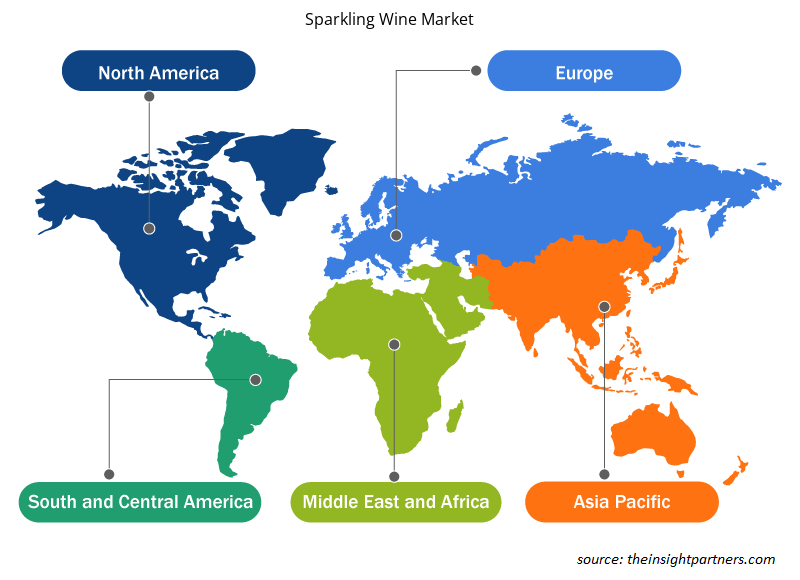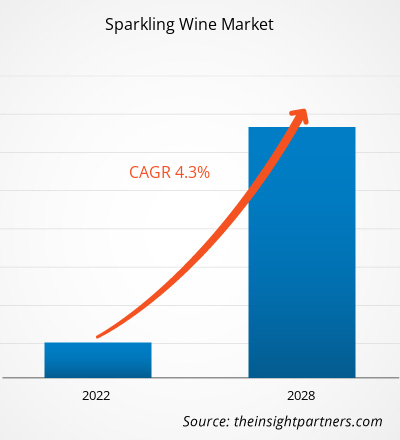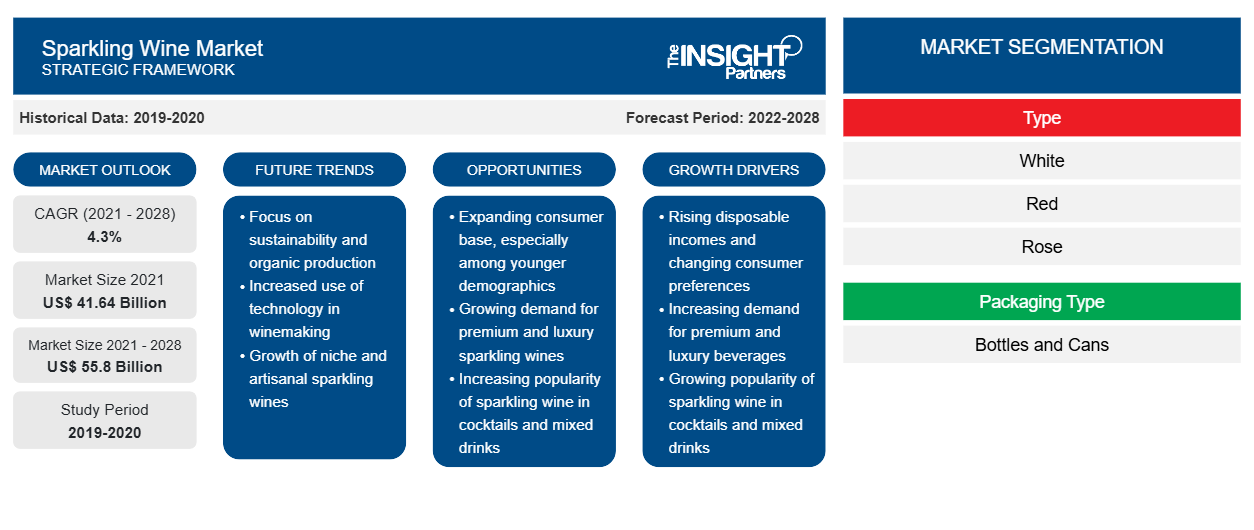Le marché des vins mousseux était évalué à 41,64 milliards de dollars américains en 2021 et devrait atteindre 55,80 milliards de dollars américains d'ici 2028 ; il devrait croître à un TCAC de 4,3 % de 2021 à 2028.
Le vin mousseux est une variante du vin à forte teneur en dioxyde de carbone, qui lui ajoute des bulles supplémentaires. Le champagne est l'un des types de vin mousseux les plus populaires. Il s'agit du vin fabriqué dans la région de Champagne en France ; cependant, de nombreux producteurs de vin mousseux aux États-Unis utilisent ce nom pour leurs produits fabriqués localement.
En 2020, l’Europe représentait la plus grande part du marché du vin mousseux . L’Union européenne (UE) compte la plus grande concentration de producteurs de vin mousseux. Selon l’Institut du vin et de la vigne, l’UE représente 70 à 80 % de la part, en volume, de la production mondiale de vin mousseux depuis 2000. Selon les experts du secteur, l’Europe exporte un plus grand volume de vin mousseux que de vin tranquille sur les marchés internationaux. La région a une longue et illustre histoire de vinification. Les amateurs de vin du monde entier préfèrent le vin mousseux européen en raison de ses saveurs, de ses goûts et de ses méthodes de préparation uniques. De plus, la préférence croissante pour les boissons moins alcoolisées, l’influence croissante des célébrités sur le mode de vie des gens, l’inclination pour les aliments et les boissons prêts à l’emploi et la tradition de déboucher une bouteille de champagne ou de vin mousseux pendant les festivités et les célébrations, entre autres, justifient l’augmentation spectaculaire de la demande pour cette catégorie de vin. L’Europe dispose d’un marché du vin mousseux très établi, qui se compose de plusieurs distillateurs importants et de petite taille.
Les producteurs de vins mousseux ont été considérablement touchés par la pénurie de main-d'œuvre pendant la pandémie de COVID-19, ce qui a entravé leur capacité de production. En outre, la fermeture des marchés de gros a obligé les fabricants à s'appuyer principalement sur les supermarchés et les revendeurs en ligne pour vendre leurs produits de vins mousseux. Malgré la pandémie, les ventes de vins rosés et mousseux ont augmenté.
Personnalisez ce rapport en fonction de vos besoins
Vous bénéficierez d'une personnalisation gratuite de n'importe quel rapport, y compris de certaines parties de ce rapport, d'une analyse au niveau des pays, d'un pack de données Excel, ainsi que de superbes offres et réductions pour les start-ups et les universités.
-
Obtenez les principales tendances clés du marché de ce rapport.Cet échantillon GRATUIT comprendra une analyse de données, allant des tendances du marché aux estimations et prévisions.
Informations sur le marché
Augmentation de la popularité du vin mousseux
Les changements socioéconomiques rapides et l'urbanisation rapide renforcent la demande de vin mousseux. Avec l'augmentation continue du niveau de vie et du pouvoir d'achat, les clients souhaitent acheter des articles de luxe de haute qualité. De plus, leurs habitudes alimentaires et leurs préférences en matière de repas changent avec ces changements de mode de vie. Ainsi, la demande de vin mousseux lors des fêtes, des mariages et des rassemblements sociaux est en hausse. Avec la préférence croissante pour les boissons à faible teneur en alcool ou sans alcool, la popularité de ce vin augmente parmi les milléniaux, les adolescents et les populations actives, ainsi que chez les célibataires et les personnes vivant dans des auberges. En outre, l'utilisation généralisée des médias sociaux et d'Internet a un impact significatif sur toutes les générations, tandis que l'augmentation du nombre de fêtes et d'événements sociaux contribue à l'augmentation de la consommation de vin mousseux à l'échelle mondiale, principalement dans les pays développés tels que les États-Unis, le Canada, le Mexique, l'Allemagne, la France et l'Italie, stimulant ainsi la croissance du marché du vin mousseux.
Informations sur les types
En fonction du type, le marché des vins mousseux est segmenté en rouge, blanc et rosé. En 2020, le segment blanc représentait la plus grande part de marché. Le vin blanc est élaboré à partir de raisins Moscato Bianco de la région viticole italienne du Piémont. Sa production est principalement concentrée à Alba et dans la province d'Asti, dans le nord de l'Italie. Les bulles sont causées par la fermentation naturelle, qui peut se produire en bouteille ou dans une grande cuve. La fermentation se produit lorsque du sucre est ajouté au vin et que la levure agit sur le sucre, générant du dioxyde de carbone. Les bulles se forment dans le vin en raison du dioxyde de carbone emprisonné dans un environnement clos.
Bacardi & Company Limited; Bronco Wine Co.; Casella; Constellation Brands, Inc.; Henkell Freixenet; Chandon; Schramsberg Wineyards; Pernod Ricard Winemakers; The Sparkling Wine Co.; Treasury Wine Estates Ltd; Bottega Spa; Campari Group; et Codorniu comptent parmi les principaux acteurs du marché des vins mousseux.
Aperçu régional du marché des vins mousseux
Les tendances et facteurs régionaux influençant le marché des vins mousseux tout au long de la période de prévision ont été expliqués en détail par les analystes d'Insight Partners. Cette section traite également des segments et de la géographie du marché des vins mousseux en Amérique du Nord, en Europe, en Asie-Pacifique, au Moyen-Orient et en Afrique, ainsi qu'en Amérique du Sud et en Amérique centrale.

- Obtenez les données régionales spécifiques au marché des vins mousseux
Portée du rapport sur le marché des vins mousseux
| Attribut de rapport | Détails |
|---|---|
| Taille du marché en 2021 | 41,64 milliards de dollars américains |
| Taille du marché d'ici 2028 | 55,8 milliards de dollars américains |
| Taux de croissance annuel moyen mondial (2021-2028) | 4,3% |
| Données historiques | 2019-2020 |
| Période de prévision | 2022-2028 |
| Segments couverts |
Par type
|
| Régions et pays couverts |
Amérique du Nord
|
| Leaders du marché et profils d'entreprises clés |
|
Densité des acteurs du marché des vins effervescents : comprendre son impact sur la dynamique commerciale
Le marché des vins mousseux connaît une croissance rapide, tirée par la demande croissante des utilisateurs finaux en raison de facteurs tels que l'évolution des préférences des consommateurs, les avancées technologiques et une plus grande sensibilisation aux avantages du produit. À mesure que la demande augmente, les entreprises élargissent leurs offres, innovent pour répondre aux besoins des consommateurs et capitalisent sur les tendances émergentes, ce qui alimente davantage la croissance du marché.
La densité des acteurs du marché fait référence à la répartition des entreprises ou des sociétés opérant sur un marché ou un secteur particulier. Elle indique le nombre de concurrents (acteurs du marché) présents sur un marché donné par rapport à sa taille ou à sa valeur marchande totale.
Les principales entreprises opérant sur le marché des vins mousseux sont :
- Bacardi et compagnie limitée
- Bronco Wine Co.
- Casella
- Constellation Brands, Inc.
- Henkell Freixenet
Avis de non-responsabilité : les sociétés répertoriées ci-dessus ne sont pas classées dans un ordre particulier.

- Obtenez un aperçu des principaux acteurs du marché des vins mousseux
Rapports en vedette
- Tendances progressives de l'industrie sur le marché mondial des vins mousseux pour aider les acteurs à développer des stratégies efficaces à long terme
- Stratégies de croissance des entreprises adoptées par les entreprises des marchés développés et en développement
- Analyse quantitative du marché mondial des vins mousseux de 2019 à 2028
- Estimation de la demande de vins mousseux auprès des consommateurs
- Analyse PEST pour illustrer l'efficacité des acheteurs et des fournisseurs opérant dans le secteur pour prédire la croissance du marché
- Développements récents pour comprendre le scénario concurrentiel du marché et la demande de vins mousseux
- Tendances et perspectives du marché associées aux facteurs qui stimulent et freinent la croissance du marché des vins mousseux
- Compréhension des stratégies qui sous-tendent l'intérêt commercial pour le marché, aidant ainsi au processus de prise de décision des acteurs du marché
- Taille du marché des vins mousseux à différents niveaux du marché
- Aperçu détaillé et segmentation du marché mondial des vins mousseux, ainsi que de sa dynamique industrielle
- Taille du marché des vins mousseux dans diverses régions avec des opportunités de croissance prometteuses
Marché des vins mousseux, par type
- Blanc
- Rouge
- Rose
Marché des vins mousseux, par type d'emballage
- Bouteilles
- Canettes
Marché des vins mousseux, par canal de distribution
- Supermarchés et hypermarchés
- Magasins spécialisés
- Vente au détail en ligne
- Autres
Profils d'entreprise
- Bacardi et compagnie limitée
- Bronco Wine Co.
- Casella
- Constellation Brands, Inc.
- Henkell Freixenet
- Vignobles de Schramsberg
- Les vignerons de Pernod Ricard
- La Compagnie des Vins Mousseux
- Domaines viticoles du Trésor Ltd
- Chandon
- Analyse historique (2 ans), année de base, prévision (7 ans) avec TCAC
- Analyse PEST et SWOT
- Taille du marché Valeur / Volume - Mondial, Régional, Pays
- Industrie et paysage concurrentiel
- Ensemble de données Excel
Rapports récents
Rapports connexes
Témoignages
Raison d'acheter
- Prise de décision éclairée
- Compréhension de la dynamique du marché
- Analyse concurrentielle
- Connaissances clients
- Prévisions de marché
- Atténuation des risques
- Planification stratégique
- Justification des investissements
- Identification des marchés émergents
- Amélioration des stratégies marketing
- Amélioration de l'efficacité opérationnelle
- Alignement sur les tendances réglementaires























 Obtenez un échantillon gratuit pour - Marché des vins mousseux
Obtenez un échantillon gratuit pour - Marché des vins mousseux